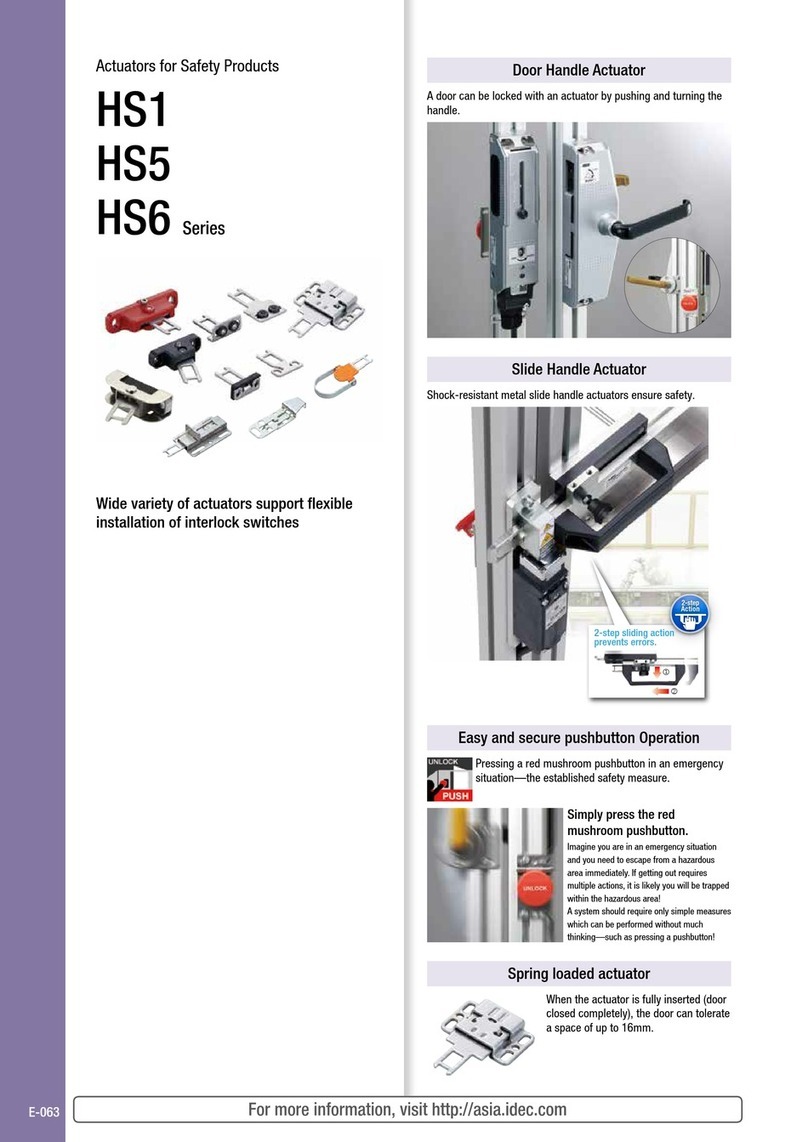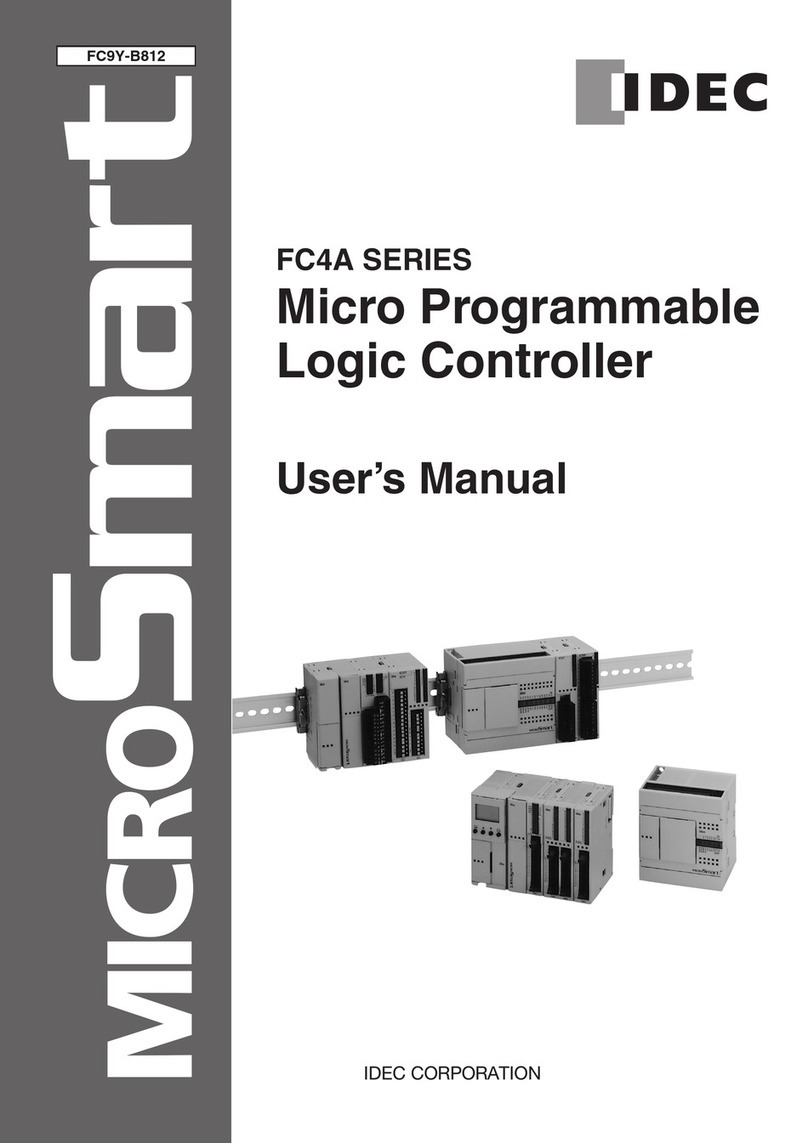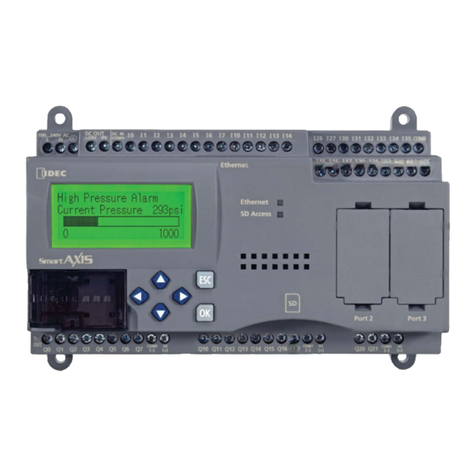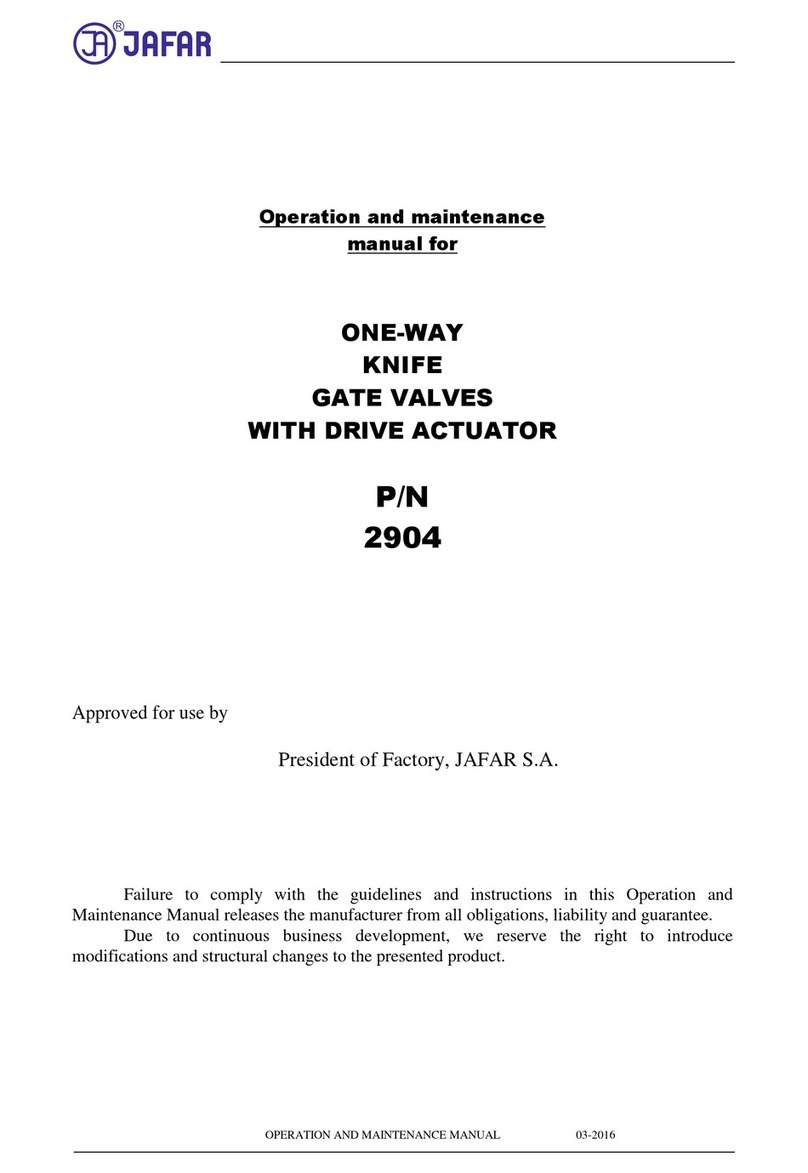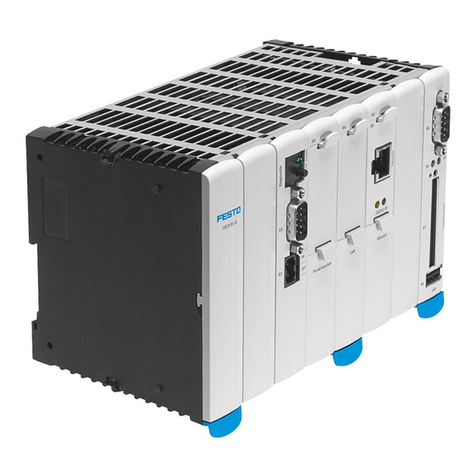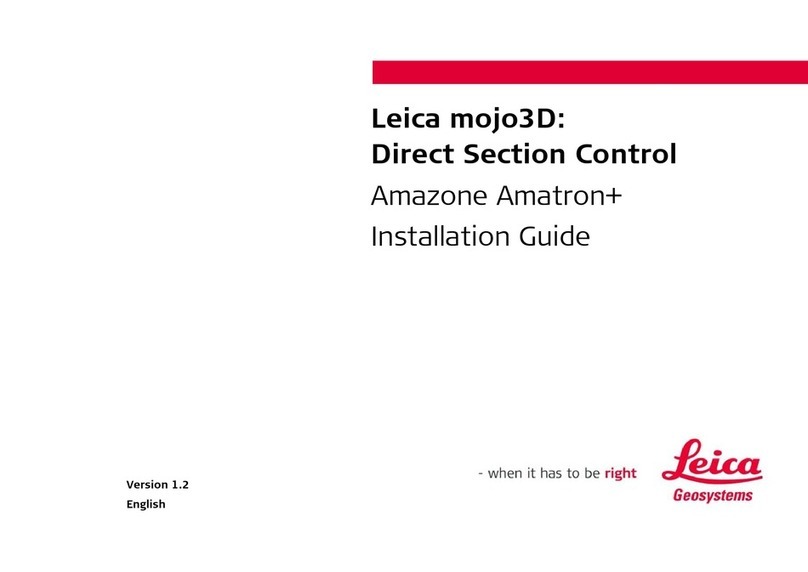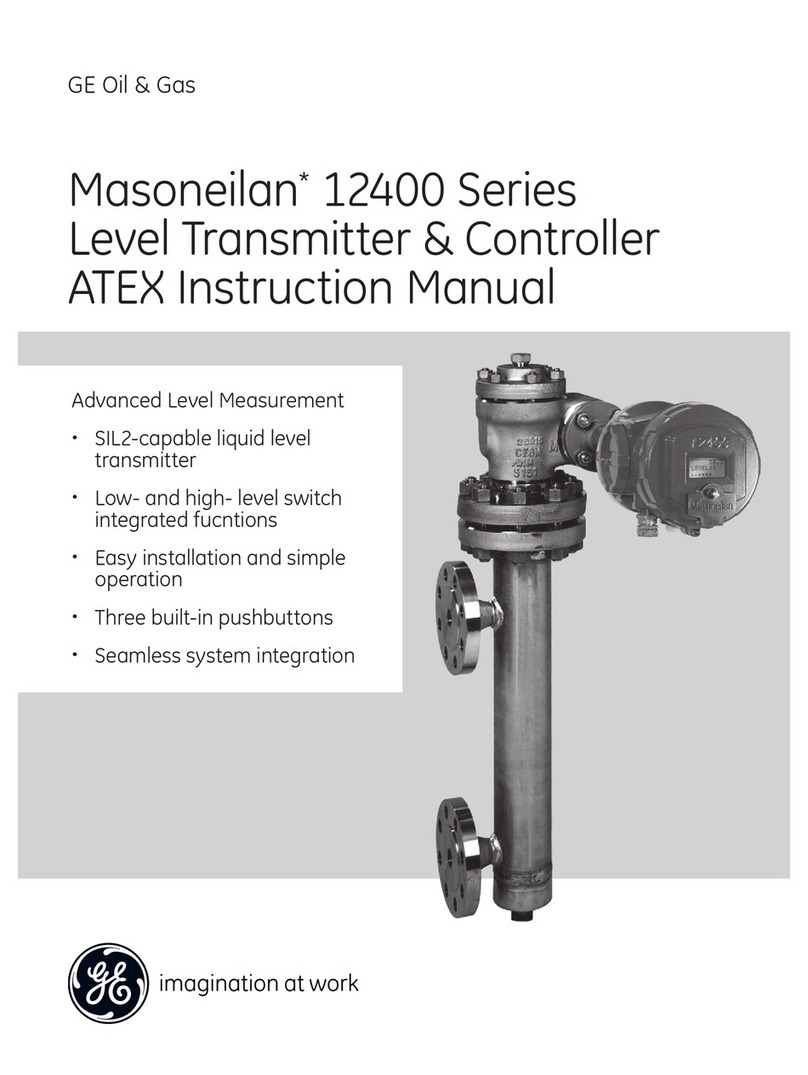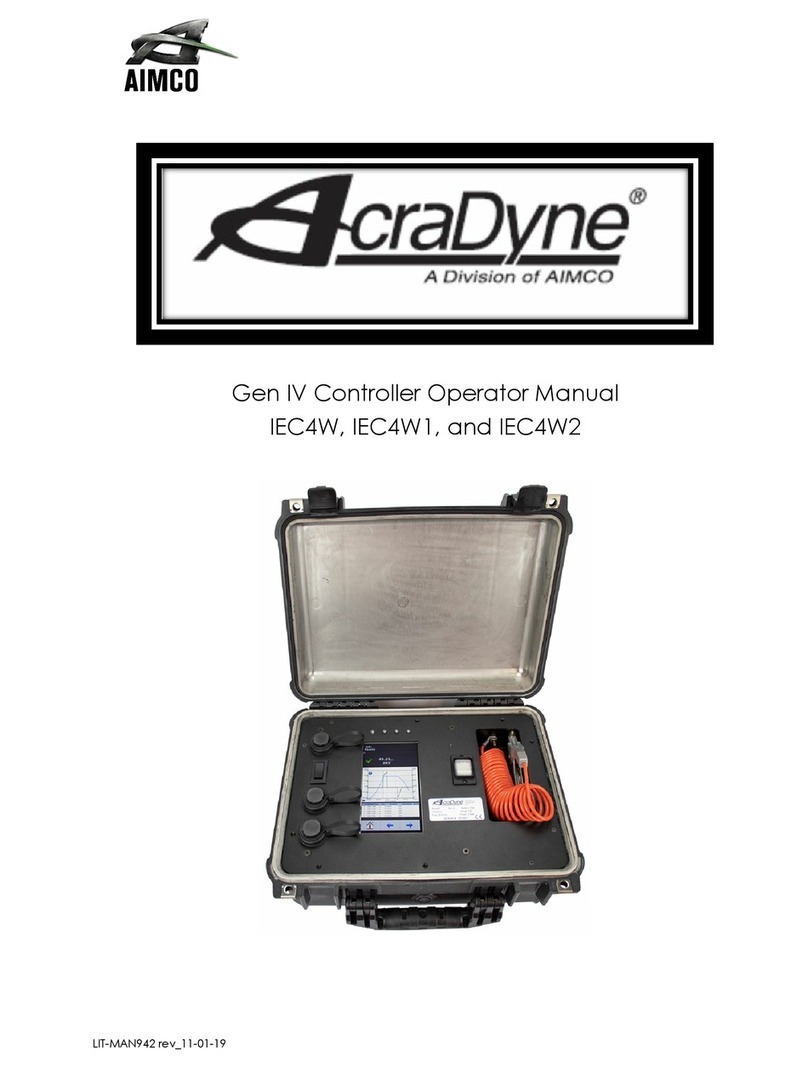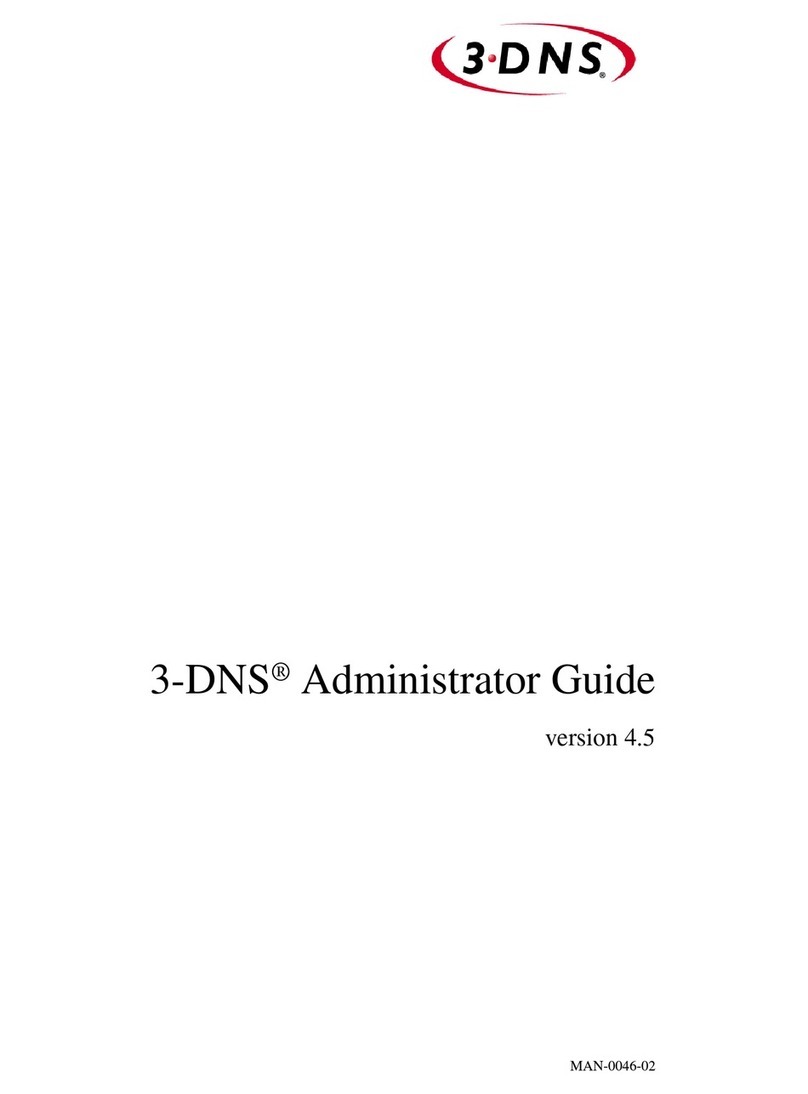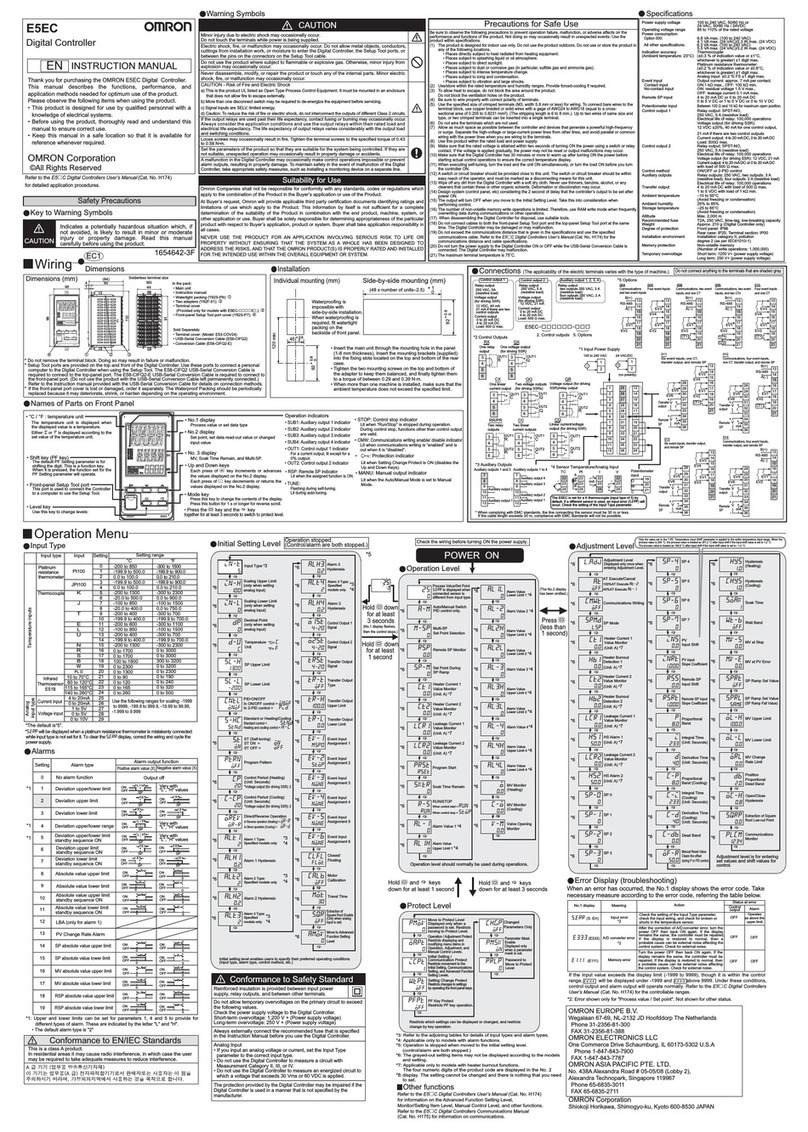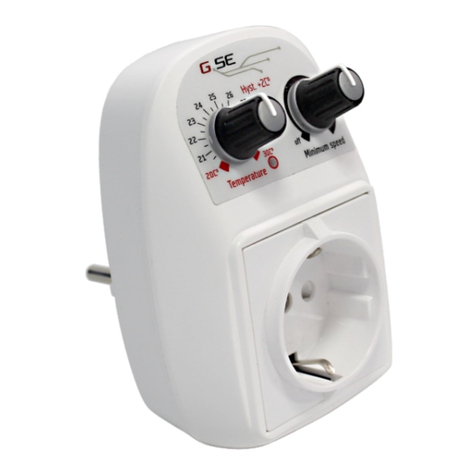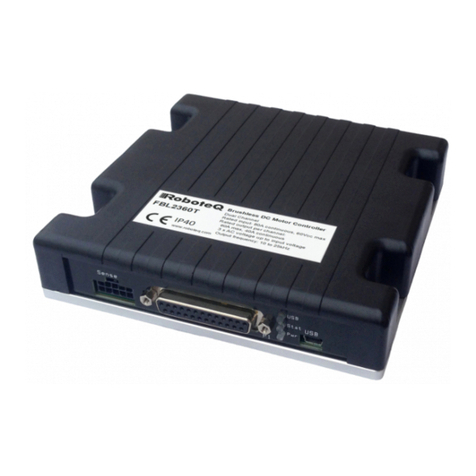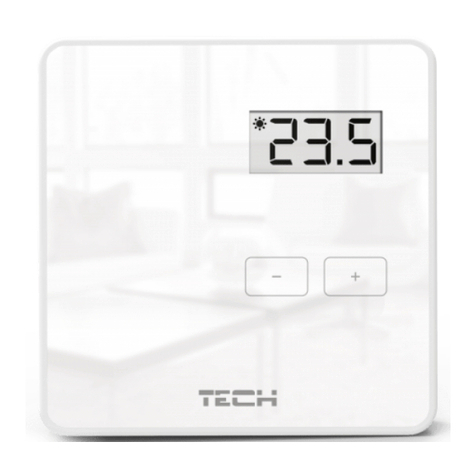IDEC MICRO3C User manual

onlinecomponents.com
U
SER
’
S
M
ANUAL
P
REFACE
-1
S
AFETY
P
RECAUTIONS
• Read this user’s manual to make sure of correct operation before starting installation, wiring, operation, maintenance, and
inspection of the
MICRO
3
C.
• All
MICRO
3
C
’s are manufactured under IDEC’s rigorous quality control system, but users must add a backup or failsafe
provision to the control system using the
MICRO
3
C
in applications where heavy damage or personal injury may be caused in
case the
MICRO
3
C
should fail.
• In this user’s manual, safety precautions are categorized in order of importance to Warning and Caution:
• Turn power off to the
MICRO
3
C
before starting installation, removal, wiring, maintenance, and inspection on the
MICRO
3
C
.
Failure to turn power off may cause electrical shocks or fire hazard.
• Special expertise is required to install, wire, program, and operate the
MICRO
3
C
. People without such expertise must not use
the
MICRO
3
C
.
• Emergency and interlocking circuits must be configured outside the
MICRO
3
C
. If such a circuit is configured inside the
MICRO
3
C
, failure of the
MICRO
3
C
may cause disorder of the control system, damage, or accidents.
• Install the
MICRO
3
C
according to instructions described in this user’s manual and the
MICRO
3
user’s manual. Improper
installation will result in falling, failure, or malfunction of the
MICRO
3
C
.
•
MICRO
3
C
is designed for installation in equipment. Do not install the
MICRO
3
C
outside of equipment.
• Install the
MICRO
3
C
in environments described in this user’s manual and the
MICRO
3
user’s manual. If the
MICRO
3
C
is used
in places where the
MICRO
3
C
is subjected to high-temperature, high-humidity, condensation, corrosive gases, excessive
vibrations, and excessive shocks, then electrical shocks, fire hazard, or malfunction will result.
•
MICRO
3
C
is designed for use in “Pollution degree 2.” Use the
MICRO
3
C
in environments of pollution degree 2 (according to
IEC664-1).
• All DC power type
MICRO
3
C
units are “PS2” type (according to EN61131).
• Prevent the
MICRO
3
C
from falling while moving or transporting the
MICRO
3
C
, otherwise damage or malfunction of the
MICRO
3
C
will result.
• Prevent metal fragments and pieces of wire from dropping inside the
MICRO
3
C
housing. Put a cover on the
MICRO
3
C
during
installation and wiring. Ingress of such fragments and chips may cause fire hazard, damage, or malfunction.
• Use a power supply of the rated value. Use of a wrong power supply may cause fire hazard.
• Use wires of a proper size to meet voltage and current requirements. Tighten M3 terminal screws to a proper tightening
torque of 0.3 to 0.5 N-m.
• Use an IEC127-approved fuse (2A maximum) on the power line outside the
MICRO
3
C
. This is required when exporting
equipment containing
MICRO
3
C
to Europe.
• Use an IEC127-approved fuse on the output circuit. This is required when exporting equipment containing
MICRO
3
C
to
Europe.
• Use an EU-approved circuit breaker. This is required when exporting equipment containing
MICRO
3
C
to Europe.
• Make sure of safety before starting and stopping the
MICRO
3
C
or when operating the
MICRO
3
C
to force outputs on or off.
Incorrect operation on the
MICRO
3
C
may cause machine damage or accidents.
• If relays in the
MICRO
3
C
output circuit fail, outputs may remain on or off. For output signals which may cause heavy acci-
dents, provide a monitor circuit outside of the
MICRO
3
C
.
• Do not connect to the ground directly from the
MICRO
3
C
. Connect a protective ground to the equipment containing
MICRO
3
C
using an M4 or larger screw. This is required when exporting equipment containing
MICRO
3
C
to Europe.
• Do not disassemble, repair, or modify the
MICRO
3
C
.
• When the battery in the
MICRO
3
C
is dead, dispose of the battery in accordance with pertaining regulations. When taking
back the dead battery to the store or disposing of the dead battery, use a proper container installed for that purpose. This is
required when exporting equipment containing
MICRO
3
C
to Europe.
• When disposing of the
MICRO
3
C
, do so as an industrial waste.
• When the battery in the memory card is dead, dispose of the battery in accordance with pertaining regulations.
Warning
Caution
Warning notices are used to emphasize that improper operation may cause
severe personal injury or death.
Caution notices are used where inattention might cause personal injury or
damage to equipment.
Warning
Caution

onlinecomponents.com
P
REFACE
-2 U
SER
’
S
M
ANUAL
MICRO
3
C USER’S MANUAL
This user’s manual primarily describes
MICRO
3
C
’s additional functions not included in the
MICRO
3
programmable control-
lers. For installation instructions, general specifications, and common functions shared with the
MICRO
3
such as basic and
advanced instructions, allocation numbers, and FUN settings, see the
MICRO
3
user’s manual.
MICRO
3
C and MICRO
3
Comparison
Program Loader for MICRO
3
C
To use the expanded capabilities of the
MICRO
3
C
such as new advanced instructions for communication and comparison
and increased data registers, use an upgraded program loader of version 2.00 or later. To check the program loader version,
read FUN31 (program loader version readout/hardware check) using the FUN31 and keys on the program loader.
To edit user programs for
MICRO
3
C
, read FUN11 (program capacity and PLC type selection) on the program loader, and
set the fourth line in the FUN11 screen to 1 to select
MICRO
3
C
as the PLC type, using the FUN11, , , , 1, and keys.
Since the loader port on the
MICRO
3Cuses RS232C communication while the loader port on the MICRO3uses RS485, a dif-
ferent loader cable is needed to connect the program loader to MICRO3Cor MICRO3. Use loader cable 3C (FC2A-KL3C) to
connect a program loader to the MICRO3Cloader port. A program loader can also be connected to the data link terminals on
the MICRO3Cusing loader cable 4C (FC2A-KL4C). In either case, loader protocol must be selected for the loader port or
data link terminals using the protocol selector switch. For selection of the protocol selector switch, see page 1-2.
Note: The upgraded program loader of version 2.00 or later can also be connected to the MICRO3using MICRO3loader
cable FC2A-KL1 or FC2A-KL2.
PLC MICRO3C MICRO3
Advanced Instructions 40
(TXD, RXD, CMP2 added; ANR1 deleted) 38
Data Registers Standard Processing 500 points 100 points
High-speed Processing 32 points 32 points
Analog Potentiometers 1 point 1 point (10 I/O type)
2 points (16/24 I/O types)
Communication
Specifications
Loader Port Standards EIA RS232C EIA RS485
Data Link
Terminal
Standards EIA RS485 EIA RS485
Baud Rate
Expansion/data link communication:
19,200 bps (fixed)
Loader protocol communication:
9,600 bps (fixed)
Expansion/data link communication:
19,200 bps (fixed)
Weight (approx.) 380g (16 I/O type)
430g (24 I/O type)
290g (10 I/O type)
350g (16 I/O type)
390g (16 I/O AC input type)
400g (24 I/O type)
Standards
EN55011 Group 1, Class A
EN50082-2
UL508, CSA C22.2, No. 142
EN61131-1, EN61131-2, EN60204-1
EN61131-1, EN61131-2, EN60204-1
IEC801-2, -3, -4
PrEN50082-2, EN55011
UL508, CSA C22.2, No. 142
Certification File No.
TÜV Product Service B950913332
UL E102542
CSA LR66809
TÜV Product Service E9 95 09 13332
313
UL E102542
CSA LR66809
IMPORTANT INFORMATION
Under no circumstances shall IDEC Corporation be held liable or responsible for indirect or consequential damages resulting
from the use of or the application of IDEC PLC components, individually or in combination with other equipment.
All persons using these components must be willing to accept responsibility for choosing the correct component to suit their appli-
cation and for choosing an application appropriate for the component, individually or in combination with other equipment.
All diagrams and examples in this manual are for illustrative purposes only. In no way does including these diagrams and
examples in this manual constitute a guarantee as to their suitability for any specific application. To test and approve all pro-
grams, prior to installation, is the responsibility of the end user.

onlinecomponents.com
USER’SMANUAL i
TABLE OF CONTENTS
CHAPTER 1: GENERAL INFORMATION
Features . . . . . . . . . . . . . . . . . . . . . . . . . . . . . . . . . . . . . . . . . . . . . . . . . . . . . . . 1-1
Parts Description . . . . . . . . . . . . . . . . . . . . . . . . . . . . . . . . . . . . . . . . . . . . . . . . . 1-1
System Setup . . . . . . . . . . . . . . . . . . . . . . . . . . . . . . . . . . . . . . . . . . . . . . . . . . . 1-3
Communication Specifications . . . . . . . . . . . . . . . . . . . . . . . . . . . . . . . . . . . . . . . 1-8
Dimensions . . . . . . . . . . . . . . . . . . . . . . . . . . . . . . . . . . . . . . . . . . . . . . . . . . . 1-10
CHAPTER 2: ALLOCATION NUMBERS
Allocation Numbers . . . . . . . . . . . . . . . . . . . . . . . . . . . . . . . . . . . . . . . . . . . . . . . 2-1
I/O Allocation Numbers for Expansion Link System . . . . . . . . . . . . . . . . . . . . . . . . 2-2
Special Internal Relays . . . . . . . . . . . . . . . . . . . . . . . . . . . . . . . . . . . . . . . . . . . . 2-3
Data Register Allocation Numbers . . . . . . . . . . . . . . . . . . . . . . . . . . . . . . . . . . . . 2-4
Expansion Control Data Registers . . . . . . . . . . . . . . . . . . . . . . . . . . . . . . . . . . . . . 2-4
CHAPTER 3: COMMUNICATION MONITOR
System Setup . . . . . . . . . . . . . . . . . . . . . . . . . . . . . . . . . . . . . . . . . . . . . . . . . . . 3-1
FUN29: User Communication Status Readout . . . . . . . . . . . . . . . . . . . . . . . . . . . . 3-1
FUN50: User Communication Data Monitor . . . . . . . . . . . . . . . . . . . . . . . . . . . . . . 3-2
CHAPTER 4: MODEM MODE
System Setup . . . . . . . . . . . . . . . . . . . . . . . . . . . . . . . . . . . . . . . . . . . . . . . . . . . 4-1
Applicable Modems . . . . . . . . . . . . . . . . . . . . . . . . . . . . . . . . . . . . . . . . . . . . . . . 4-1
Internal Relays for Modem Mode . . . . . . . . . . . . . . . . . . . . . . . . . . . . . . . . . . . . . 4-2
Data Registers for Modem Mode . . . . . . . . . . . . . . . . . . . . . . . . . . . . . . . . . . . . . 4-2
Originate Mode . . . . . . . . . . . . . . . . . . . . . . . . . . . . . . . . . . . . . . . . . . . . . . . . . . 4-3
Disconnect Mode . . . . . . . . . . . . . . . . . . . . . . . . . . . . . . . . . . . . . . . . . . . . . . . . 4-5
AT General Command Mode . . . . . . . . . . . . . . . . . . . . . . . . . . . . . . . . . . . . . . . . . 4-5
Answer Mode . . . . . . . . . . . . . . . . . . . . . . . . . . . . . . . . . . . . . . . . . . . . . . . . . . . 4-6
Initialization String Commands . . . . . . . . . . . . . . . . . . . . . . . . . . . . . . . . . . . . . . . 4-7
Preparation before Using Modem . . . . . . . . . . . . . . . . . . . . . . . . . . . . . . . . . . . . . 4-8
Setting Communication Parameters . . . . . . . . . . . . . . . . . . . . . . . . . . . . . . . . . . . 4-8
Programming Data Registers and Internal Relays . . . . . . . . . . . . . . . . . . . . . . . . . . 4-8
Operating Procedure . . . . . . . . . . . . . . . . . . . . . . . . . . . . . . . . . . . . . . . . . . . . . . 4-9
Sample Program for Modem Originate Mode . . . . . . . . . . . . . . . . . . . . . . . . . . . . . 4-9
Checking Modem Operation . . . . . . . . . . . . . . . . . . . . . . . . . . . . . . . . . . . . . . . . 4-10
CHAPTER 5: USER COMMUNICATION INSTRUCTIONS
B1 TXD (Transmit) . . . . . . . . . . . . . . . . . . . . . . . . . . . . . . . . . . . . . . . . . . . . . . 5-1
B2 RXD (Receive) . . . . . . . . . . . . . . . . . . . . . . . . . . . . . . . . . . . . . . . . . . . . . . 5-8
CHAPTER 6: COMPARISON INSTRUCTION
B3 CMP2 (Double-word Comparison) . . . . . . . . . . . . . . . . . . . . . . . . . . . . . . . . . 6-1
CHAPTER 7: COMPUTER LINK
Computer Link 1:N Communication . . . . . . . . . . . . . . . . . . . . . . . . . . . . . . . . . . . . 7-1
Computer Link 1:N Communication Using Modems . . . . . . . . . . . . . . . . . . . . . . . . 7-2
RS232C/RS485 Converter FC2A-MD1 . . . . . . . . . . . . . . . . . . . . . . . . . . . . . . . . . 7-3
RS232C Cable HD9Z-C52 . . . . . . . . . . . . . . . . . . . . . . . . . . . . . . . . . . . . . . . . . . 7-4
AC Adapter . . . . . . . . . . . . . . . . . . . . . . . . . . . . . . . . . . . . . . . . . . . . . . . . . . . . . 7-4

onlinecomponents.com
TABLE OF CONTENTS
ii USER’SMANUAL
CHAPTER 8: SAMPLE PROGRAM – USER COMMUNICATION TXD
System Setup . . . . . . . . . . . . . . . . . . . . . . . . . . . . . . . . . . . . . . . . . . . . . . . . . . . 8-1
Description of Operation . . . . . . . . . . . . . . . . . . . . . . . . . . . . . . . . . . . . . . . . . . . . 8-1
Programming Expansion Control Data Registers . . . . . . . . . . . . . . . . . . . . . . . . . . . 8-1
Setting Communication Parameters . . . . . . . . . . . . . . . . . . . . . . . . . . . . . . . . . . . 8-2
Ladder Diagram . . . . . . . . . . . . . . . . . . . . . . . . . . . . . . . . . . . . . . . . . . . . . . . . . . 8-2
CHAPTER 9: SAMPLE PROGRAM – USER COMMUNICATION TXD & RXD
System Setup . . . . . . . . . . . . . . . . . . . . . . . . . . . . . . . . . . . . . . . . . . . . . . . . . . . 9-1
Description of Operation . . . . . . . . . . . . . . . . . . . . . . . . . . . . . . . . . . . . . . . . . . . . 9-1
Setting Communication Parameters . . . . . . . . . . . . . . . . . . . . . . . . . . . . . . . . . . . 9-2
BASIC Program Display Example . . . . . . . . . . . . . . . . . . . . . . . . . . . . . . . . . . . . . . 9-2
BASIC Program . . . . . . . . . . . . . . . . . . . . . . . . . . . . . . . . . . . . . . . . . . . . . . . . . . 9-3
Ladder Diagram . . . . . . . . . . . . . . . . . . . . . . . . . . . . . . . . . . . . . . . . . . . . . . . . . . 9-4
CHAPTER 10: SAMPLE PROGRAM – MODEM COMMUNICATION
System Setup . . . . . . . . . . . . . . . . . . . . . . . . . . . . . . . . . . . . . . . . . . . . . . . . . . 10-1
Allocation Numbers (Remote Station) . . . . . . . . . . . . . . . . . . . . . . . . . . . . . . . . . 10-2
Allocation Numbers (Local Station) . . . . . . . . . . . . . . . . . . . . . . . . . . . . . . . . . . . 10-3
Description of Operation . . . . . . . . . . . . . . . . . . . . . . . . . . . . . . . . . . . . . . . . . . . 10-3
Ladder Diagram (Remote Station) . . . . . . . . . . . . . . . . . . . . . . . . . . . . . . . . . . . . 10-4
Ladder Diagram (Local Station) . . . . . . . . . . . . . . . . . . . . . . . . . . . . . . . . . . . . . . 10-6
CHAPTER 11: TROUBLESHOOTING
Error Causes and Actions . . . . . . . . . . . . . . . . . . . . . . . . . . . . . . . . . . . . . . . . . . 11-1
User Communication Error . . . . . . . . . . . . . . . . . . . . . . . . . . . . . . . . . . . . . . . . . 11-2
Troubleshooting Diagrams . . . . . . . . . . . . . . . . . . . . . . . . . . . . . . . . . . . . . . . . . 11-3
APPENDIX
Type List . . . . . . . . . . . . . . . . . . . . . . . . . . . . . . . . . . . . . . . . . . . . . . . . . . . . . . . A-1
ASCII Character Code Table . . . . . . . . . . . . . . . . . . . . . . . . . . . . . . . . . . . . . . . . . A-2
INDEX

onlinecomponents.com
USER’SMANUAL 1-1
1: GENERAL INFORMATION
Introduction
This chapter describes general information about additional functions and specifications incorporated in the MICRO3C. For
general information, functions, and specifications inherited from the MICRO3, see the MICRO3User’s Manual.
Features
MICRO3Chas upgraded functions for communications. The new functions are particularly useful for modem communica-
tion, user communication, and monitoring data communication.
User Communication Function
MICRO3Chas an RS232C loader port in place of the RS485 loader port on the MICRO3. The more widely applicable
RS232C loader port can be directly connected to any equipment with an RS232C communication port.
New advanced instructions for transmitting and receiving data make it possible to set up a communication system using
various communication formats.
The user communication function can be used only in the standard processing mode, not in the high-speed processing
mode.
Increased Data Registers
Since data communication requires more data registers, MICRO3Chas 500 data registers (D0 through D499) expanded
from 100 data registers in the MICRO3. All expanded data registers except D499 can be used to program instructions.
In the high-speed processing mode, available data registers are limited to 32 (D0 through D31) as with the MICRO3.
Double-word Comparison of Data Registers
Double-word comparison instruction is added to compare data in data registers. Two consecutive data registers designated
by a source operand are compared with two consecutive data registers designated by another source operand. When used
with a repeat designation, one double-word comparison instruction can execute a maximum of 31 double-word compari-
son operations. With a repeat designation, the results of all double-word comparisons can not only be available individu-
ally but also be ANDed; so the comparison results can be easily determined even when comparing a large quantity of data.
Parts Description
The figure above illustrates the 16-I/O
type MICRO3Cbase unit.
Function Selector Switch
Selects the station function in the expansion or data link system.
Analog Potentiometer
Sets the analog value for the analog timer, frequency, or pulse width
of pulse outputs.
MICRO3Chas only one potentiometer while 16- and 24-I/O type
MICRO3base units have two potentiometers.
Loader Port
For connecting the program loader or computer. The loader port can
also be used as a user communication port when user protocol is
selected with the protocol selector switch.
01
3
701
26
54
DATA LINK
ASGB
56710
3
701
26
54
Protocol Selector Switch
Selects the communication protocol for the loader port (loader proto-
col or user protocol) and the data link terminals (data link/expansion
link or loader protocol).
Data Link Terminals
For connecting the data link line in the expansion link or data link
system. The data link terminals can also be used for connecting the
program loader or computer when loader protocol is selected with the
protocol selector switch.
Communication Enable Button
Enables the communication mode selected with the protocol selector
switch. When the protocol selector switch setting is changed while
the MICRO3Cis powered up, press this button to enable the new com-
munication mode for the loader port and data link terminals.

onlinecomponents.com
1: GENERAL INFORMATION
1-2 USER’SMANUAL
Protocol Selector Switch
The protocol selector switch is used to select communication modes for the RS232C loader port and the RS485 data link
terminals. When the MICRO3Cis powered up, the selected communication modes are enabled automatically. If the protocol
selector switch setting is changed after the MICRO3Cis powered up, the new setting does not take effect until the commu-
nication enable button is depressed.
Communication Protocols for Loader Port and Data Link Terminals
Loader protocol: The protocol used for communication between MICRO3Cand program loader or CUBIQ on computer.
User protocol: The protocol used for user communication instructions (RS232C)
Data link protocol: The protocol used for communication in the expansion link or data link (RS485).
Note 1: When the protocol selector switch is set to 4, the communication parameters for the loader port are arbitrarily set
to the default values of FUN8 (loader port communication mode setting); baud rate 9,600 bps, terminator code 0D, 7 data
bits, even parity, 1 stop bit, and receive timeout 500 msec. Any change in FUN8 values does not take effect. The communi-
cation parameters for the data link terminals using the loader protocol are fixed and the same as the FUN8 default values.
Note 2: When the protocol selector switch is set to 5 through 7, the ERR1 indicator on the MICRO3Cblinks and the
MICRO3Cdoes not start to run.
Communication Enable Button
While the MICRO3Cis powered up, pressing the communication enable button for more than 4 seconds until the ERR1
indicator blinks once makes the MICRO3Cread the settings on the protocol selector switch and function selector switch.
Then the MICRO3Cupdates the communication modes for the loader port and data link terminals. This button is useful
when you want to change the communication mode without turning power off.
Function Selector Switch
When the protocol selector switch is set to 0 or 1, the data link terminals can be used for expansion link or data link com-
munication. Then the function selector switch selects the station function for each MICRO3Cin the expansion link or data
link system. The function of the function selector switch on the MICRO3Cis the same as that on the MICRO3. When the pro-
tocol selector switch is set to 2 through 4 to select loader protocol for the data link terminals, the function selector switch
setting has no effect.
MICRO3C Station Function by Function Selector Switch Position
Protocol Selector Switch Position Loader Port Protocol Data Link Terminal Protocol Remarks
0Loader protocol Data link protocol
1User protocol Data link protocol
2Loader protocol Loader protocol
3User protocol Loader protocol
4Loader protocol Loader protocol For maintenance (Note 1)
5 through 7 Reserved Reserved (Note 2)
Function Selector Switch Position MICRO3C Station Function
0Base or master station
1Slave station 1
2Slave station 2
3Slave station 3
4Slave station 4
5Slave station 5
6Slave station 6
7Expansion station
Warning If the communication enable button is pressed while the MICRO3Cis in operation, the user program
execution is stopped and all outputs are forced off.

onlinecomponents.com
1: GENERAL INFORMATION
USER’SMANUAL 1-3
System Setup
This section describes various system configurations using the MICRO3Cand required settings.
Selecting Communication Mode
Set the function selector switch and the protocol selector switch to select a desired communication mode for the loader
port and data link terminals. After changing the settings of the function selector switch and protocol selector switch while
the MICRO3Cis powered up, press the communication enable button for more than 4 seconds until the ERR1 indicator
blinks once; then the new communication mode takes effect. When the MICRO3Cis powered up, the MICRO3Cchecks the
settings of the function selector switch and protocol selector switch and enables the selected communication mode auto-
matically. You have to press the communication enable button only when you change the communication mode while the
MICRO3Cis powered up.
Connecting Program Loader to the Loader Port
When connecting a program loader to the loader port on the MICRO3C, set the protocol selector switch to 0, 2, or 4 to select
loader protocol for the loader port. Use the loader cable 3C to connect the program loader to the MICRO3Cloader port.
Connecting the Cable
The program loader has a cover on the top to select the loader cable
connection port or AC adapter jack. Slide the cover to the right to open
the loader cable connection port.
Connect the connector of the loader cable to the loader cable connec-
tion port on the program loader and the other connector of the cable to
the loader port on the MICRO3Cas indicated on the direction labels.
Warning If the communication enable button is pressed while the MICRO3Cis in operation, the user program
execution is stopped and all outputs are forced off.
Caution Special cables are needed to connect to the loader port on the MICRO3C. Loader cables for the
MICRO3such as FC2A-KL1 (2m/6.56 ft. long) and FC2A-KL2 (5m/16.4 ft. long) cannot be used for
the MICRO3C. Cables used for connecting to the loader port on the MICRO3Ccannot be used for the
MICRO3. If a wrong cable is used, machine damage may result.
When connecting and disconnecting the
loader cable, be sure to hold the connec-
tor. Since the connector has a latch, the
cable cannot be removed holding the
cable.
Make sure of correct direction of the
cable as indicated on the direction labels
attached near the connectors on the cable.
Loader Cable 3C
FC2A-KL3C (2m/6.56 ft. long)
The loader cable 3C has an
RS232C/RS485 converter in
the middle.
Slide the cover to the right
Loader Cable Connection Port

onlinecomponents.com
1: GENERAL INFORMATION
1-4 USER’SMANUAL
Connecting Program Loader to the Data Link Terminals
A program loader can also be connected to the data link terminals on the MICRO3Cwhen the protocol selector switch is set
to 2, 3, or 4 to select loader protocol for the data link terminals. This capability is particularly useful to monitor the com-
munication data transmitted through the loader port while user communication or modem communication is performed
with the protocol selector switch set to 3.
Connecting the Cable
The program loader has a cover on the top to select the loader cable
connection port or AC adapter jack. Slide the cover to the right to
open the loader cable connection port.
Connect the connector of the loader cable to the loader cable con-
nection port on the program loader and the three spade terminals on
the other end of the cable to the data link terminals on the MICRO3C
as indicated on the marker tubes.
Connecting an AC Adapter
Connect an AC adapter to the power supply box in the middle of the
loader cable 4C to supply power to the program loader. Applicable
output plug of the AC adapter is shown on the right.
Loader Cable 4C
FC2A-KL4C (2m/6.56 ft. long)
The loader cable 4C has a power
supply box in the middle.
AC Adapter (Output: 5V DC)
The loader cable 4C is not supplied with
an AC adapter, which must be prepared
by the user.
Note: AC adapters for IDEC’s FA series
PLCs cannot be used.
(RS485)
(RS485)
Slide the cover to the right
Loader Cable Connection Port
9.5 ø2.1
ø5.5
Polarity
+–
Dimensions in mm.
Caution When a program loader or computer running CUBIQ is connected to the data link terminals and a
communication device is connected to the loader port at the same time to perform communications
shown below, multi-stage comparison instruction HSC1 cannot be used.
Data link terminals: Used for loader protocol communication
Loader port: Used for loader protocol communication at 19,200 bps

onlinecomponents.com
1: GENERAL INFORMATION
USER’SMANUAL 1-5
Computer Link through Loader Port
To set up a 1:1 computer link system, connect an IBM PC or compatible to the MICRO3Cusing the computer link cable 4C
(FC2A-KC4C). Set the protocol selector switch to 0, 2, or 4 to select loader protocol for the loader port.
Computer Link through Data Link Terminals
A 1:1 computer link system can also be set up through the data link terminals on the MICRO3Cusing the computer link
cable 6C (FC2A-KC6C). Set the protocol selector switch to 2, 3, or 4 to select loader protocol for the data link terminals.
Computer Link Cable 4C
FC2A-KC4C
3m (9.84 ft.) long
To RS232C Port
To Loader Port
(RS232C) D-sub 9-pin
Female Connector
Cable Connector Pinouts
Pin Description
1DCD Data Carrier Detect
2RXD Receive Data
3TXD Transmit Data
4DTR Data Terminal Ready
5GND Signal Ground
6DSR Data Set Ready
7——
8CTS Clear to Send
9——
Computer Link Cable 6C
FC2A-KC6C
2m (6.56 ft.) long To RS232C Port
RS232C/RS485
Converter
D-sub 9-pin
Female Connector
Cable Connector Pinouts
Pin Description
1——
2RXD Receive Data
3TXD Transmit Data
4——
5GND Signal Ground
6——
7RTS Request to Send
8CTS Clear to Send
9——
Connect the three spade ter-
minals on the computer link
cable 6C to data link termi-
nals A, B, and SG as indi-
cated on the maker tubes.
A
B
SG
AC Adapter
Output: 5V DC
Connect an AC adapter to the RS232C/RS485 converter in the
middle of the computer link cable 6C.
The computer link cable 6C is not supplied with an AC adapter,
which must be prepared by the user.
For applicable output plug of the AC adapter, see page 1-4.
Note: AC adapters for IDEC’s FA series PLCs cannot be used.
(RS485)
ABSG

onlinecomponents.com
1: GENERAL INFORMATION
1-6 USER’SMANUAL
Connecting Modem through Loader Port
To connect a modem to the loader port on the MICRO3C, use the modem cable 1C (FC2A-KM1C). Set the protocol selector
switch to 1 or 3 to select user protocol for the loader port.
Connecting RS232C Equipment through Loader Port
To connect equipment with an RS232C communication port to the loader port on the MICRO3C, use the user communica-
tion cable 1C (FC2A-KP1C). One end of the user communication cable 1C is not provided with a connector, and it can be
terminated with a proper connector to plug in to communicate with the RS232C port.
When the protocol selector switch is set to 1 or 3, MICRO3Ccan communicate with RS232C equipment through the loader
port using the user protocol. When the protocol selector switch is set to 0, 2, or 4, MICRO3Ccan communicate through the
loader port using the loader protocol.
Modem Cable 1C
FC2A-KM1C
3m (9.84 ft.) long
To RS232C Port
To Loader Port
(RS232C) D-sub 25-pin
Male Connector
Cable Connector Pinouts
Pin Description
1FG Frame Ground
2TXD Transmit Data
3RXD Receive Data
4RTS Request to Send
5——
6——
7SG Signal Ground
8DCD Data Carrier Detect
20 DTR Data Terminal Ready
Modem
User Communication Cable 1C
FC2A-KP1C
2.4m (7.87 ft.) long To RS232C Port
To Loader Port
(RS232C) Attach a proper connector to the
open end referring to the cable
connector pinouts shown below.
Cable Connector Pinouts
Pin Description AWG# Color
1RTS Request to Send 28 Twisted Black
2DTR Data Terminal Ready 28 Yellow
3TXD Transmit Data 28 Blue
4RXD Receive Data 28 Green
5DSR Data Set Ready 28 Brown
6SG Signal Ground 28 Gray
7SG Signal Ground 26 Twisted Red
8NC No Connection 26 White
Cover — Shield — —
RS232C Equipment
Signal Direction

onlinecomponents.com
1: GENERAL INFORMATION
USER’SMANUAL 1-7
Link Systems
MICRO3Chas three link functions; expansion link, data link, and computer link. When using a link function, the function
selector switch and protocol selector switch have to be set and the FUN settings may be required. For details of these set-
tings, see Expansion Link Function and Data Link Function in the MICRO3User’s Manual and Computer Link 1:N Com-
munication on page 7-1 in this manual. The expansion link cannot be used in the data link system.
Expansion Link System
The expansion link system consists of two MICRO3Cor MICRO3base units connected through the data link terminals using
the optional expansion cable FC2A-KE1 (250 mm/9.84" long) or a shielded twisted pair cable as shown below. The cable
for the expansion link system can be extended up to 200 meters (656 feet). Every MICRO3Cor MICRO3base unit can be
used as an expansion station.
Data Link System
The data link system consists of one master station connected to a maximum of six slave stations to communicate control
data for distributed control. Every MICRO3Cor MICRO3base unit can be used as a master or slave station. When a slave sta-
tion performs communication at 19,200 bps through the loader port, multi-stage comparison instruction HSC1 cannot be
used at the slave station.
Computer Link System
In the computer link system, a personal computer is connected to one or a maximum of 32 MICRO3Cbase units to control
the operation of all MICRO3Cbase units. The 1:1 computer link system requires the computer link cable 4C (FC2A-KC4C)
or computer link cable 6C (FC2A-KC6C). The 1:N computer link system using MICRO3Cbase units requires RS232C/
RS485 converter FC2A-MD1 and cables; computer link interface unit FC2A-LC1 is not required.
Base Station
Function selector switch: 0
Protocol selector switch: 0 or 1
Expansion Station
Function selector switch: 7
Protocol selector switch: 0 or 1
The RUN indicator on the expan-
sion station remains off whether the
base station is running or stopped.
Master Station
Function selector switch: 0
Protocol selector switch: 0 or 1
Slave Station 6
Function selector switch: 6
Protocol selector switch: 0 or 1
Slave Station 2
Function selector switch: 2
Protocol selector switch: 0 or 1
Slave Station 1
Function selector switch: 1
Protocol selector switch: 0 or 1
RS232C/RS485
Converter
FC2A-MD1
1st Unit
Function selector switch: 0
Protocol selector switch: 2, 3, or4
FUN9: 0
2nd Unit
Function selector switch: 0
Protocol selector switch: 2, 3, or 4
FUN9: 1
Nth Unit (N ≤32)
Function selector switch: 0
Protocol selector switch: 2, 3, or 4
FUN9: N–1
The figure above illustrates a 1:N computer link system for MICRO3C.

onlinecomponents.com
1: GENERAL INFORMATION
1-8 USER’SMANUAL
Communication Specifications
This section describes the MICRO3Ccommunication specifications. For general specifications, function specifications, I/O
specifications, and program loader specifications, see the MICRO3User’s Manual.
Loader Port Communication Specifications
User Communication Mode Specifications
When the protocol selector switch is set to 1 or 3 to select user protocol for the loader port, the MICRO3Ccan communicate
through the loader port with external equipment which has an RS232C port, such as a computer, modem, printer, or bar-
code reader.
Using transmit and receive instructions for user communication, user programs can be created to match the communica-
tion protocol of the equipment to communicate with. Determine the possibility of communication referring to the user
communication mode specifications described below:
Standards EIA RS232C
Maximum Cable Length 15m (49.2 ft.)
Communication
Parameters
Baud Rate 1200, 2400, 4800, 9600, 19200 bps
Data Bits 7 or 8 bits
Parity Odd, Even, None
Stop Bits 1 or 2 bits
Receive Timeout
10 to 2550 msec
(In the user communication, receive timeout is disabled when 2550 msec is
selected.)
Connection to Program Loader Using optional loader cable 3C (FC2A-KL3C)
Connection to RS232C Equipment Using optional user communication cable 1C (FC2A-KP1C) or other cables
Standards EIA RS232C
Control Signal TXD, RXD, DTR, RTS, DSR
Baud Rate 1200, 2400, 4800, 9600, 19200 bps
Data Bits 7 or 8 bits
Parity Odd, Even, None
Stop Bits 1 or 2 bits
Receive Timeout 10 to 2550 msec (10-msec increments) or none
(Receive timeout is disabled when 2550 msec is selected.)
Communication Method Start-stop synchronization system half-duplex
Maximum Transmit Data 200 bytes
Maximum Receive Data 200 bytes

onlinecomponents.com
1: GENERAL INFORMATION
USER’SMANUAL 1-9
Data Link Terminal Communication Specifications
Data Link Terminal Communication with Program Loader
When the protocol selector switch is set to 2, 3, or 4 to select loader protocol for the data link terminals, the MICRO3Ccan
communicate through the data link terminals with the program loader or computer to monitor the MICRO3Coperation,
transfer user programs, and perform other communications. The communication parameters using the loader protocol for
the data link terminals are fixed to the same values as the FUN8 (loader port communication mode setting) default shown
below and cannot be selected unlike the communication through the loader port.
Data Link Terminal Communication Parameters (Loader Protocol)
When the protocol selector switch is set to 2 or 4, the MICRO3Ccan perform loader communication through both the loader
port and data link terminals at the same time. If data write operation (write N bytes or write 1 bit) is attempted to the same
operand through both the loader port and data link terminals at the same time, the command through the data link termi-
nals has priority although communication error does not occur at both ports.
1. While a user program is written through either the loader port or data link terminals, a user program cannot be written
through the other port.
The prior write user program operation is executed normally, but the subsequent write user program operation results
in a protect error.
2. While a user program is written through either the loader port or data link terminals, a user program cannot be read
through the other port.
The prior write user program operation is executed normally, but the subsequent read user program operation results in
a protect error.
3. A user program cannot be read through either the loader port or data link terminals if a user program is written through
the other port before the read user program operation is completed.
The subsequent write user program operation is executed normally, but the prior read user program operation may fail
to read the complete user program and result in a CRC error.
Standards EIA RS485 (termination resistor is not required)
Recommended Cable ø0.9 mm shielded twisted cable
Conductor Resistance 85 Ω/km maximum
Shield Resistance 12 Ω/km maximum
Maximum Cable Length 200m (656 ft.)
Isolation Between data link terminals of multiple MICRO3C units: Not isolated
Baud Rate Expansion or data link communication: 19200 bps (fixed)
Loader protocol communication: 9600 bps (fixed)
Communication Delay
Expansion link: Master station normal scan time + approx. 9 to 10 msec
Data link: Master station normal scan time + approx. 12.5 to 13 msec + Slave
station scan time
Connection to Program Loader Using optional loader cable 4C (FC2A-KL4C)
Baud Rate 9600 bps
Terminator Code 0D (CR)
Data Bits 7 bits
Parity Even
Stop Bit 1 bit
Receive Timeout 500 msec
Caution Some of the program transfer operation cannot be performed as described below:

onlinecomponents.com
1: GENERAL INFORMATION
1-10 USER’SMANUAL
Dimensions
85 mm (3.346")
16-I/O Type: 135 mm (5.315")
24-I/O Type: 165 mm (6.496")
60 mm (2.362")
95 mm (3.740")
30 mm
(1.181")
185 mm (7.283")
80 mm (3.150") 25 mm
(0.984")
16-I/O Type: 116 mm (4.567")
24-I/O Type: 146 mm (5.748")
M4 tapped holes or
ø4.5 (0.177" dia.) drilled holes
77 mm
Minimum center to center
Minimum
29 mm (1.142")
(3.031")
center to center
58 mm (2.283")
Mounting Hole Layout
MICRO3C Base Unit Program Loader

onlinecomponents.com
USER’SMANUAL 2-1
2: ALLOCATION NUMBERS
Introduction
This chapter describes allocation numbers available only for the MICRO3C. For details about allocation numbers shared
with the MICRO3, see the MICRO3User’s Manual.
Expanded functions in the MICRO3Cinclude:
MICRO3Chas 500 data registers D0 through D499 while MICRO3has 100 data registers D0 through D99. D499 is used to
enable or disable expansion control data registers D484 through D498 and cannot be used as an ordinary data register to
store data.
Special internal relay M307 has different functions when used as a base or expansion station in the expansion link system
or when used as a master station or slave station in the data link system.
Allocation Numbers
Available I/O numbers depend on the type and combination of the MICRO3Cbase units used in the expansion link system.
For details of available I/O numbers in the expansion link system, see the next page.
Notes: Input and output allocation numbers for the expansion station start with I20 and Q20. For the I/O allocation num-
bers in the expansion link system, see the next page.
The maximum points shown in ( ) are values for the high-speed processing mode.
The same number cannot be used for a counter and a timer in a user program.
Internal relays M260 through M287 have special functions in the modem mode. See page 4-2.
Data register D499 is reserved to enable or disable expansion control data registers D484 through D498 and cannot be
used as an ordinary data register to store data. For details, see page 2-4.
Operand Processing Mode Allocation Number Maximum Points
Input
Standard and
High-speed I0 - I7 I10 - I15 14 points (Base)
+
14 points (Expansion)
Standard only I20 - I27 I30 - I35
Output
Standard and
High-speed Q0 - Q7 Q10 - Q11 10 points (Base)
+
10 points (Expansion)
Standard only Q20 - Q27 Q30 - Q31
Internal Relay
Standard and
High-speed
M0 - M7 M10 - M17 M20 - M27
M30 - M37 M40 - M47
232 points
(40 points)
Standard only
M50 - M57 M60 - M67 M70 - M77
M80 - M87 M90 - M97 M100 - M107
M110 - M117 M120 - M127 M130 - M137
M140 - M147 M150 - M157 M160 - M167
M170 - M177 M180 - M187 M190 - M197
M200 - M207 M210 - M217 M220 - M227
M230 - M237 M240 - M247 M250 - M257
M260 - M267 M270 - M277 M280 - M287
Catch Input Relay Standard and
High-speed M290 - M297 8 points
(8 points)
Special Internal
Relay
Standard and
High-speed M300 - M307 M310 - M317 16 points
(16 points)
Timer
Standard and
High-speed T0 - T15
32 points total
(16 points total)
Standard only T16 - T31
Counter
Standard and
High-speed C0 - C15
Standard only C16 - C31
Shift Register
Standard and
High-speed R0 - R31 64 points
(32 points)
Standard only R32 - R63
Data Register
Standard and
High-speed D0 - D31 500 points
(32 points)
Standard only D32 - D499

onlinecomponents.com
2: ALLOCATION NUMBERS
2-2 USER’SMANUAL
I/O Allocation Numbers for Expansion Link System
Input and output allocation numbers do not continue from the base station to the expansion station. At the expansion sta-
tion, inputs start at I20 and outputs start at Q20. Inputs and outputs are allocated depending on the MICRO3Cbase units
used in the expansion link system as shown below:
I/O Points MICRO3C Base Station
I/O Allocation Numbers
MICRO3C Expansion Station
I/O Allocation Numbers
Total IN/OUT
16 9/7
16-I/O Type
———
I0 - I7
I10 Q0 - Q6
24 14/10
24-I/O Type
———
I0 - I7
I10 - I15
Q0 - Q7
Q10 - Q11
32 18/14
16-I/O Type 16-I/O Type
I0 - I7
I10 Q0 - Q6 I20 - I27
I30 Q20 - Q26
40 23/17
16-I/O Type 24-I/O Type
I0 - I7
I10 Q0 - Q6 I20 - I27
I30 - I35
Q20 - Q27
Q30 - Q31
24-I/O Type 16-I/O Type
I0 - I7
I10 - I15
Q0 - Q7
Q10 - Q11
I20 - I27
I30 Q20 - Q26
48 28/20
24-I/O Type 24-I/O Type
I0 - I7
I10 - I15
Q0 - Q7
Q10 - Q11
I20 - I27
I30 - I35
Q20 - Q27
Q30 - Q31

onlinecomponents.com
2: ALLOCATION NUMBERS
USER’SMANUAL 2-3
Special Internal Relays
Internal relays M290 through M317 are special internal relays with the following functions:
Note: M290 through M297 and M301 are used only for reading in the user program, but can be directly set or reset using
the program loader or optional software CUBIQ on a computer.
M307 Link Communication Initialize Flag (Master Station)/Link Communication Stop Flag (Slave Station)
Special internal relay M307 has different functions when used as a base or expansion station in the expansion link system
or when used as a master station or slave station in the data link system.
Base or master station: Link communication initialize flag
When M307 at the base or master station is turned on during operation, the link configuration is checked to initialize the
expansion or data link system. When an expansion station or slave station is powered up after the base or master station,
turn M307 on to initialize the link system. After an expansion link or data link setup is changed, M307 must also be turned
on to ensure correct communication.
Slave station: Link communication stop flag
When a slave station does not receive communication data from the master station for 800 msec or more in the data link
system, M307 turns on. When the slave station receives correct communication data, M307 turns off.
In the expansion station, M307 has no effect and cannot be monitored using the program loader.
Allocation Number Description CPU Stopped Power OFF
M290
Catch Input Status Set
(See Note below)
Input I0 Operating Cleared
M291 Input I1 Operating Cleared
M292 Input I2 Operating Cleared
M293 Input I3 Operating Cleared
M294 Input I4 Operating Cleared
M295 Input I5 Operating Cleared
M296 Input I6 Operating Cleared
M297 Input I7 Operating Cleared
M300 Start Control Maintained Maintained
M301 Initialize Pulse (See Note below) Cleared Cleared
M302 All Outputs OFF Cleared Cleared
M303 Carry (Cy) or Borrow (Bw) Cleared Cleared
M304 User Program Execution Error Cleared Cleared
M305 Link Communication Error
(Expansion mode and data link mode) Maintained Cleared
M306 Link Communication Prohibit Flag
(Expansion mode and data link mode) Maintained Maintained
M307
Link Communication Initialize Flag (Master Station)
(Expansion mode and data link mode) Cleared Cleared
Link Communication Stop Flag (Slave Station)
(Data link mode)
M310 1-sec Clock Reset Cleared Cleared
M311 1-sec Clock Operating Cleared
M312 100-msec Clock Operating Cleared
M313 10-msec Clock Operating Cleared
M314 Timer/Counter Preset Value Changed Maintained Maintained
M315 High-speed Counter Soft Reset Maintained Cleared
M316 High-speed Counter (HSC3) Overflow Cleared Cleared
M317 In-operation Output Cleared Cleared

onlinecomponents.com
2: ALLOCATION NUMBERS
2-4 USER’SMANUAL
Data Register Allocation Numbers
Available data registers are limited in the high-speed processing mode or in the data link system configuration. Some data
registers are allocated to special functions in the data link system as shown below. For the data link function, see the
MICRO3User’s Manual. D100 through D209, D492, and D493 have special functions in the modem mode. See page 4-2.
Note: When FUN10 is set to enable control data registers, selected data registers D90 through D99 work as control data
registers; others can be used as ordinary data registers. For details of the data link function, see the MICRO3User’s Manual.
Expansion Control Data Registers
Data registers D484 through D499 are allocated as expansion control data registers. D499 is used to enable or disable
expansion control data register service for D484 through D498 divided into group 0 through 3. Data registers in the group
disabled for expansion control data registers can be used as ordinary data registers.
D499 cannot be used as an ordinary data register and must not be programmed to store data of operation results.
Data Register
Number
Standard Processing Mode High-speed
Processing Mode
Other than Data Link Data Link
(Master Station)
Data Link
(Slave Station)
D0 to D31
Available
Available Available
Available
D32 to D59
Not available
D60 to D84 For data link
D85 to D89 For data link
D90 to D99 Can be designated as control data registers using FUN10. (Note)
D100 to D483 Available
D484 to D485 When expansion control data register service is enabled for each group of these
data registers using D499, the selected data registers work as expansion con-
trol data registers; others can be used as ordinary data registers.
When expansion control data register service is disabled using D499, these
data registers can be used as ordinary data registers.
D486 to D491
D492 to D495
D496 to D498
D499 Reserved to enable or disable expansion control data register service.
Group Expansion Control DR Description
—D499 Expansion control data register service selection
0
D498 Day (Calendar)
D497 Month (Calendar)
D496 Year (Calendar)
1
D495 Modem mode selection
D494 Reserved
D493 Modem mode status
D492 Protocol selection in modem mode
2
D491 Control signal status
D490 DSR control signal option
Available only for communication through
the loader port using user protocol
(protocol selector switch set to 1 or 3)
D489 DTR control signal option
D488 RTS control signal option
D487 Reserved
D486 RTS control signal ON/OFF timer
3
D485 (Lower byte) Protocol selector switch value
D485 (Upper byte) For maintenance
D484 (Lower byte) Function selector switch value
D484 (Upper byte) For maintenance

onlinecomponents.com
2: ALLOCATION NUMBERS
USER’SMANUAL 2-5
D499 Expansion Control Data Register Service Selection
D499 is used to enable or disable expansion control data register service for D484 through D498 divided into group 0
through 3.
Store a value in D499 to enable or disable expansion control data service for group 0 through 3 as described below:
The D499 value marked with indicates that the data registers in the corresponding group are enabled for expansion con-
trol data register service. The enable/disable of expansion control data register service is determined by the lower 4 bits in
D499. Although a value over 15 can be entered to D499, upper 12 bits do not take effect.
Group 0
D498 Day (Calendar)
D497 Month (Calendar)
D496 Year (Calendar)
When group 0 is enabled as expansion control data registers, the calendar data are stored to D496 through D498. The year
is indicated with the lower 2 digits.
Group 1
D495 Modem mode selection
When group 1 is enabled as expansion control data registers and “1” is set to D495, the modem mode is enabled. When
“0” is set to D495, the modem mode is disabled. For the modem mode, see page 4-1.
D494 Reserved
D493 Modem mode status
When the modem mode is enabled (see above), D493 stores a modem mode status.
D492 Protocol selection in modem mode
When the modem mode is enabled (see above), the protocol at the loader port is switched from the user protocol depend-
ing on the value in D492 after the telephone line is connected.
D492 = 1: User protocol is continued at the loader port
D492 = 0: Loader protocol is enabled at the loader port
Group D499 Value
0123456789101112131415
0 (D496-D498)
1 (D492-D495)
2 (D486-D491)
3 (D484-D485)
D493 Value Description Remarks
30h AT command completed normally AT command (start IR) is completed normally.
31h Issuing AT command
32h AT command execution error See the result code stored in data registers D104 through D119.
Check the modem power, modem cable, and the remote modem.
33h Two or more start IRs are on Correct the program so that only one start IR goes on at a time.
34h Modem mode enabled
35h Start IR program error Correct the program so that only the disconnect command is issued
while the line is connected.
36h (Reserved)
37h (Reserved)
38h Retrying AT command
39h AT command program error Correct the program to include 0Dh in the AT command.
Warning
D499 cannot be used as an ordinary data register and must not be programmed to store data of oper-
ation results. If an unexpected value is set to D499, the modem mode may be enabled or disabled
during operation.
Table of contents
Other IDEC Controllers manuals
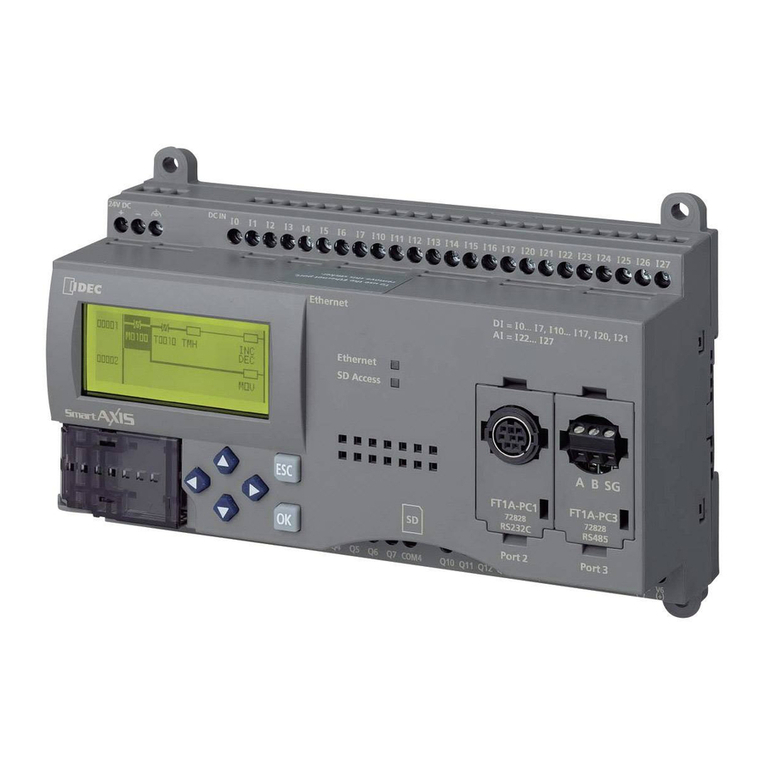
IDEC
IDEC SmartAXIS Touch FT1A Series User manual
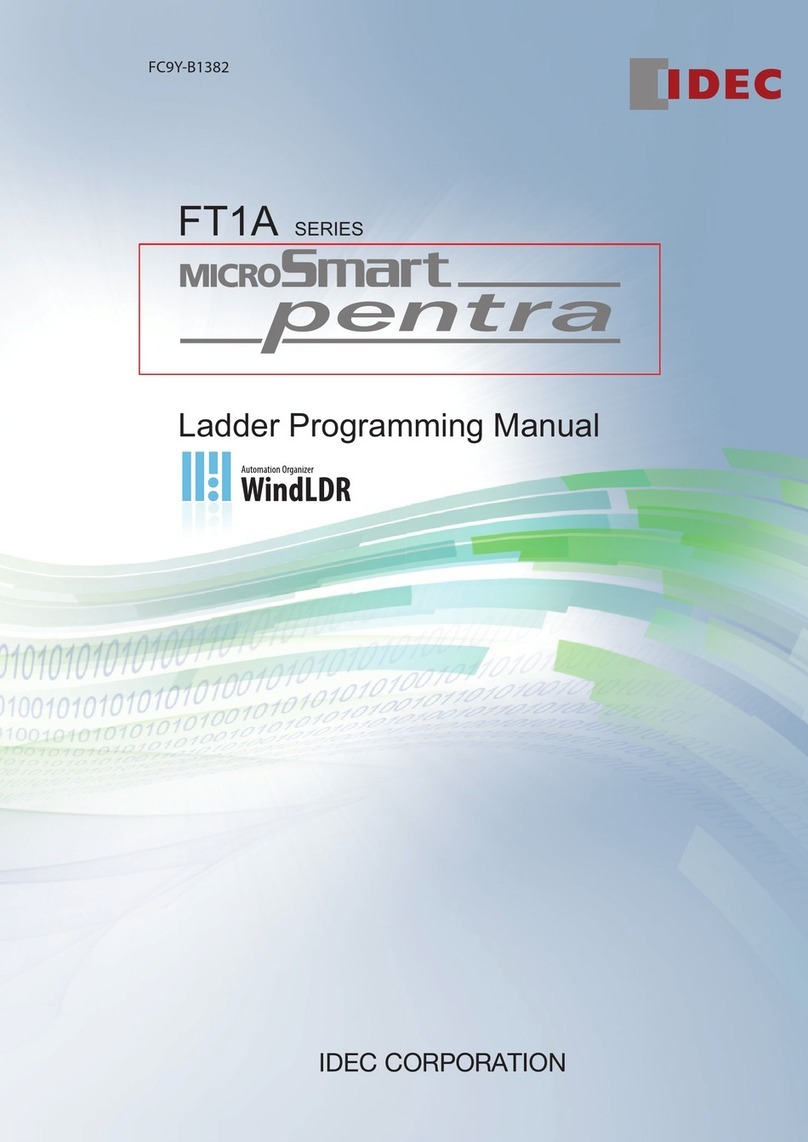
IDEC
IDEC microsmart pentra Owner's manual
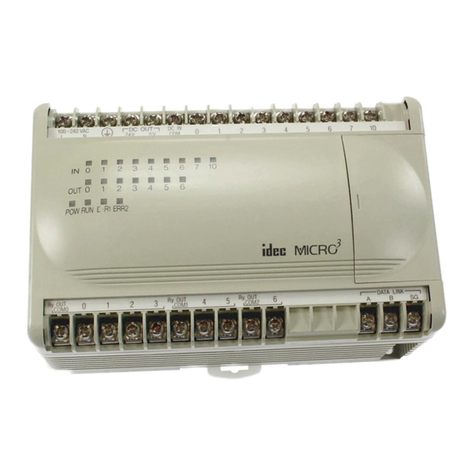
IDEC
IDEC MICRO3 User manual
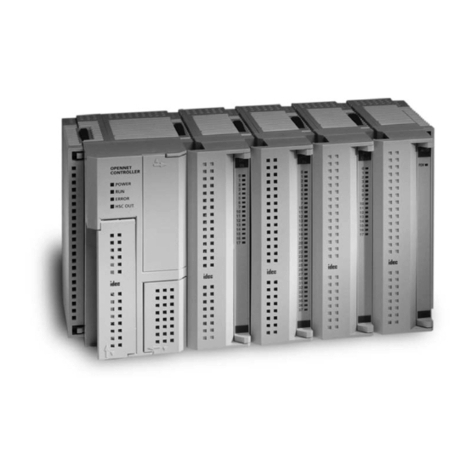
IDEC
IDEC OpenNet series User manual
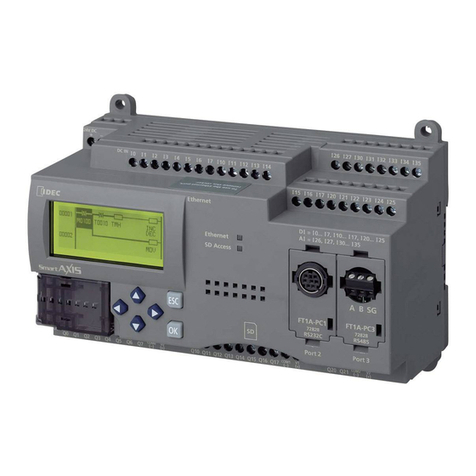
IDEC
IDEC SmartAXIS Touch FT1A Series User manual
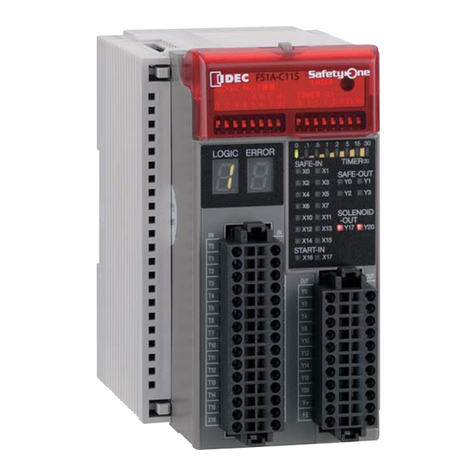
IDEC
IDEC FS1A-C11S User manual
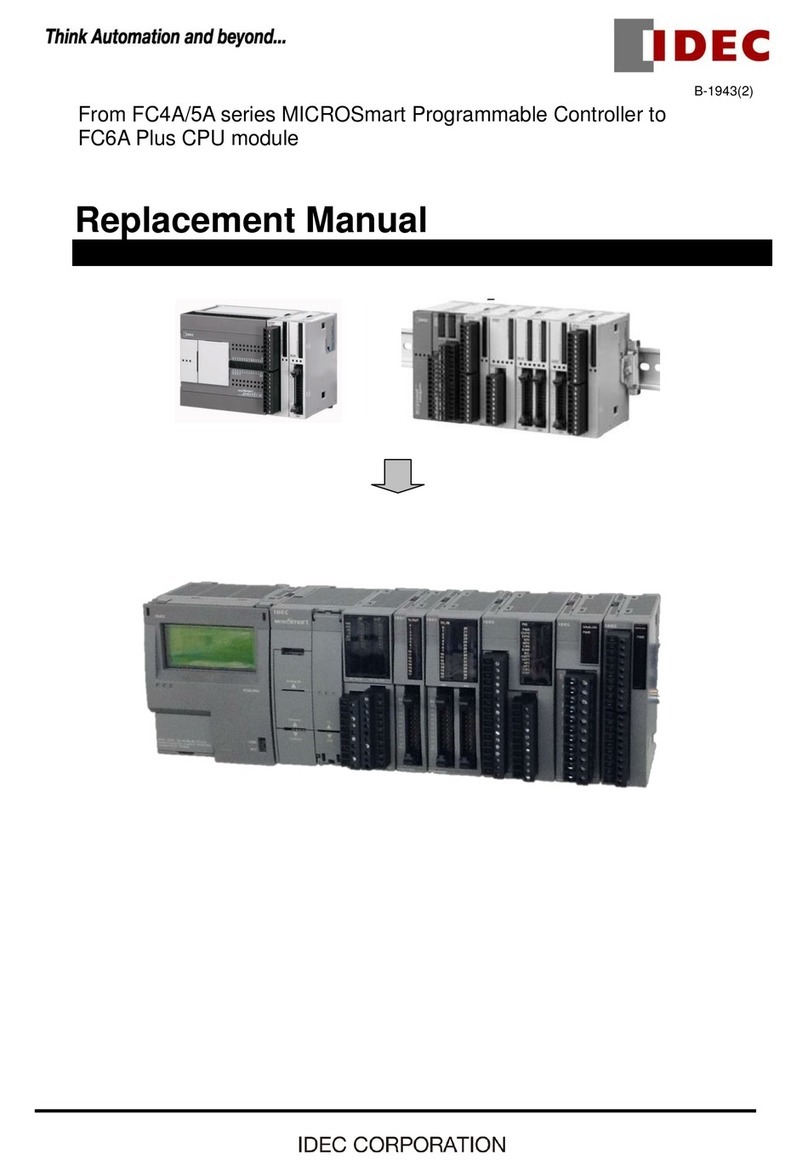
IDEC
IDEC MICROSmart FC4A Series Operating and safety instructions
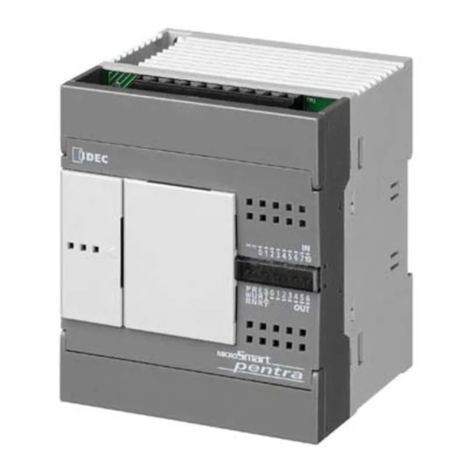
IDEC
IDEC MICROSmart FC5A Series User manual
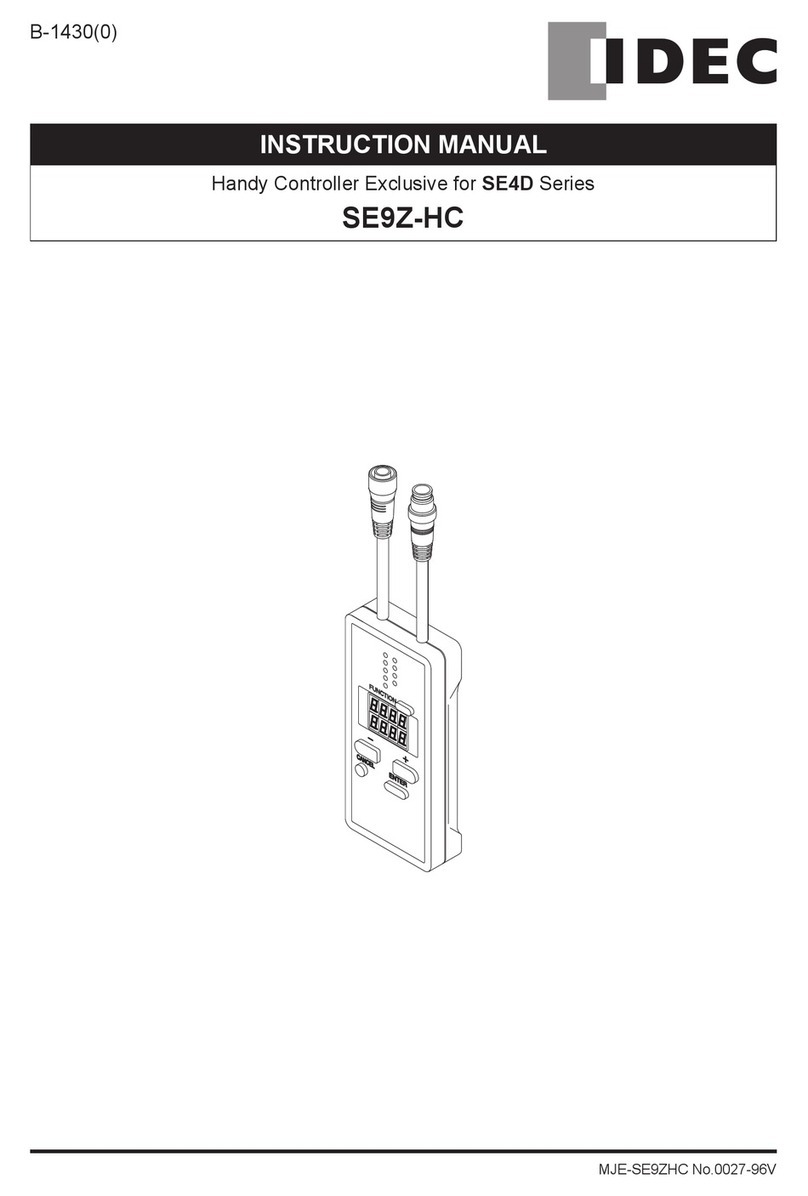
IDEC
IDEC SE9Z-HC User manual
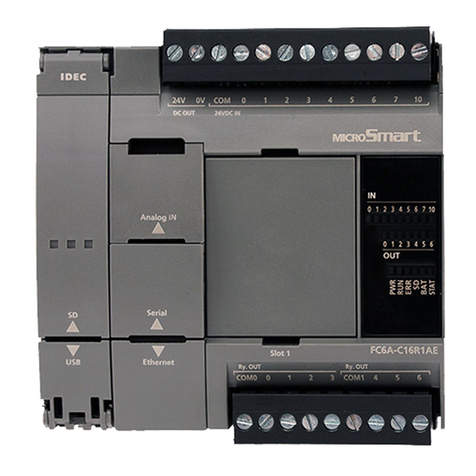
IDEC
IDEC MICROSmart FC6A Series Owner's manual


